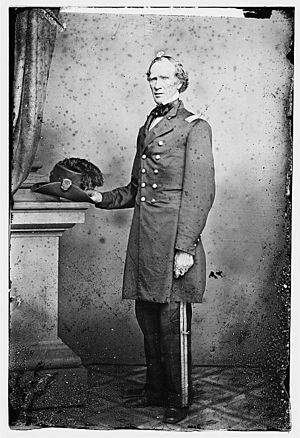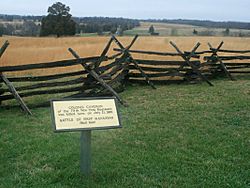James Cameron (Union colonel) facts for kids
Quick facts for kids
James Cameron
|
|
|---|---|
 |
|
| Born | March 1, 1800 Maytown, Pennsylvania |
| Died | July 21, 1861 (aged 61) Manassas, Virginia |
| Buried | |
| Allegiance | United States of America |
| Service/ |
Union Army |
| Years of service | 1861 |
| Rank | |
| Commands held | 79th New York Volunteer Infantry |
| Battles/wars | American Civil War |
James Cameron (March 1, 1800 – July 21, 1861) was a man from Pennsylvania who became a colonel in the 79th New York Volunteer Infantry Regiment. This regiment was part of the Union Army during the start of the American Civil War.
James Cameron was the older brother of Simon Cameron. Simon was a powerful U.S. Senator and the first United States Secretary of War for President Abraham Lincoln. At 61 years old, James Cameron was killed in action. This happened during the First Battle of Bull Run on July 21, 1861. This battle was the first major fight of the Civil War.
Early Life and Career
James Cameron was born on March 1, 1800, in Maytown, Pennsylvania. His parents were Charles Cameron and Martha Pfoutz. His older brother, Simon, was born a year earlier.
When James was eight, his family moved to Northumberland County, Pennsylvania. His father died there within a year. This left his mother with eight children and no money. So, James and Simon had to start working very young.
James Cameron had many different jobs throughout his life. He worked as a cowboy, a farmer, and a blacksmith. He was also a printer, a lawyer, and a railroad manager. At age 19, James worked in the same print shop as his brother Simon. He later became an editor for newspapers. In 1827, he edited the "Political Sentinel" in Lancaster, Pennsylvania. He also studied law with James Buchanan, who later became a U.S. President.
In 1829, Cameron married Rebecca (Lemon) Galbraith. He managed railroads and practiced law. In 1847, he went with Pennsylvania troops to the Mexican–American War. He was a sutler, meaning he sold supplies to the soldiers. After this war, he became a colonel in the Pennsylvania militia. Before the Civil War started, Cameron was either retired or managing a railroad.
Service in the Civil War
When the Civil War began, James Cameron felt it was his duty to serve. He went to Washington, D.C. The 79th New York Volunteer Infantry Regiment was one of the first units to arrive there. This regiment was known as the "Highlanders." This was because many of its first members were from Scotland or had Scottish family.
The 79th Regiment needed a colonel. They offered the job to James Cameron. He was a well-known man of Scottish descent. Also, he was the brother of Simon Cameron, the Secretary of War. James Cameron accepted the position on June 20, 1861. By the time the regiment was full, many of its soldiers were actually of Irish background, not Scottish.
On July 7, 1861, the 79th New York Infantry moved into Virginia. This was part of the Union Army's advance led by Major General Irvin McDowell. This advance led to the First Battle of Bull Run. The 79th Regiment was in the division of Brigadier General Daniel Tyler. It was part of the brigade led by Colonel William T. Sherman.
On July 18, 1861, the 79th New York Infantry took part in a scouting mission. They came under fire from Confederate soldiers. The Union forces could not break through the Confederate line at the Battle of Blackburn's Ford.
Colonel Cameron's Death
During the First Battle of Bull Run, the 79th New York Infantry advanced on Henry House Hill. This was a key moment in the battle. Colonel Cameron was on the right side of his regiment's line. He shouted, "Come on, my brave Highlanders!" or "Scots, follow me!" as they moved forward.
A soldier in the 79th New York, William Todd, wrote about the battle. He said that as the regiment was halfway up the hill, they were hit hard by Confederate gunfire. A Confederate Colonel, Wade Hampton III, reportedly said about Cameron: "Isn't it terrible to see that brave officer trying to lead his men forward and they won't follow him."
Cameron kept trying to lead his men forward. He bravely led charges to try and get back Union cannons that were lost on Henry House Hill. After being pushed back, the regiment regrouped. But then they were hit by another volley of shots. This volley killed Colonel Cameron and wounded more soldiers.
Cameron was talking to a lieutenant when a bullet hit him in the chest. He fell and died quickly from heavy bleeding. His body was taken to an ambulance wagon. At first, the driver didn't want to take a dead body. But when he learned it was Colonel Cameron, he agreed. However, Confederate soldiers soon captured the ambulance wagons. They used them for their own wounded soldiers.
So, Colonel James Cameron, the brother of the U.S. Secretary of War, died during the first major battle of the Civil War. His brother, Simon Cameron, was actually among the people who came from Washington, D.C., to watch the battle.
After Colonel Cameron's death, the 79th New York Infantry was hit again. The remaining soldiers, who had suffered many losses, had to retreat. The 79th New York "Highlanders" had 32 soldiers killed, 51 wounded, and 115 missing. Confederate forces, including Hampton's Legion, fought off four Union regiments, including the 79th New York, in a short time. Colonel Wade Hampton was slightly wounded during this fight. Hampton's strong defense gave Stonewall Jackson's brigade enough time to reach that important part of the battlefield.
Aftermath
Colonel Cameron's body was left on the battlefield. Attempts to get it back from the Confederates failed. A letter asking for its return was rejected because of how it was addressed. The Confederates said they would not accept it unless it was addressed properly.
Cameron's body was not found until March 1862. This was when the Confederate army left the Manassas area. A group led by Cameron's adjutant, Sgt. John Kane, found a slave who had helped bury the dead. The slave said Cameron's body had been unburied for a few days in the hot summer. Then it was placed in a common grave with other Union soldiers. The slave remembered where it was buried because a reward was offered for its recovery.
When they dug in the spot the slave pointed out, they found Cameron's remains. They also found the remains of several other soldiers. Cameron's body was identified by his clothes and a hernia truss he wore. His personal items and $80 in cash were gone. The slave said Confederate cavalrymen had taken anything valuable from the body. After carefully removing his remains, they were taken back to Washington. Finally, James Cameron was buried in the Lewisburg Cemetery in Lewisburg, Pennsylvania.


